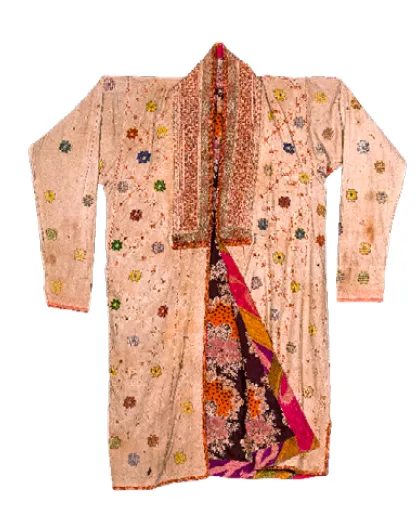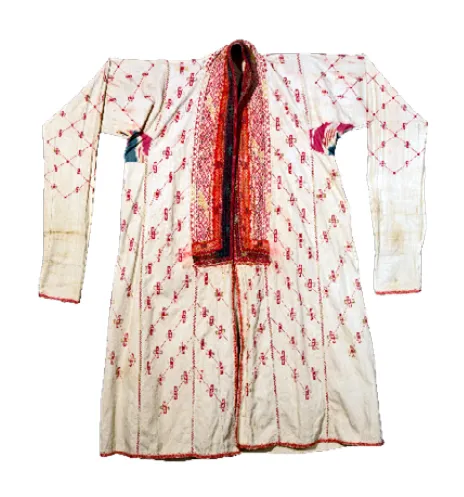An opportunity to visit the famous Savitsky Museum of Arts became a real blessing for him. It was that visit that inspired the researcher to begin collecting things.
One the most interesting types of women’s clothes is the kiymeshek – a ritual (wedding) shawl covering the head and chest. Items of this type form the largest portion of the collection and are represented by about 400 (!) examples. A kiymeshek consists of three parts: the head with a facial opening, the front in the form of a truncated triangle (kiymeshek aldy) and the back (kuyryksha). The kuyryksha consists of a square piece of Bukharan silk (or semi-silk) ikat attached with its corner to the top of the kiymeshek. Black strips on the shoulders connect on both sides the first and second parts of the mantle.
Young women used to wear a kiymeshek with a front (kyzyl kiymeshek aldy) made of red imported cloth (kyzyl ushyg), while that for aged women had a front (ak kiymeshek aldy) made of white cotton fabric (boz). The bride-to-be was to weave and embroider the kiymeshek herself; she began making the item in her adolescent years. Every day, before starting the work, she was to say a prayer.
Another type of clothing demonstrating the refined taste of Karakalpak embroideresses is ak zhegde – a white mantle-robe for aged women. Like ak kiymeshek aldy, it was made of white homemade fabric. The upper part of the front, the back and sleeves are embroidered with purple, green and blue silk thread with geometric and stylised vegetal motifs. Counted-thread cross-stitch embroidery (shatrash) and hardanger embroidery on a white ground are predominant techniques. A dangling hand-like ornament known locally as garga tyrnak (“the raven’s claws”) is attached to the hem of ak zhegde.
You can learn more about the topic in the book-album "The Cultural legacy of Uzbekistan in private collections of the USA and Canada" (volume XXXI) in the series "Cultural Legacy of Uzbekistan in the World Collections".
The main sponsor of the project is the oilfield services company Eriell-Group.



